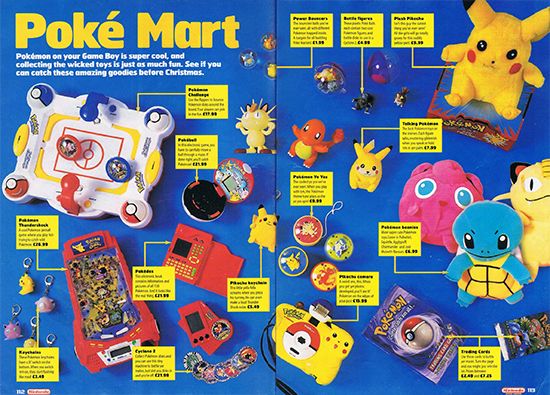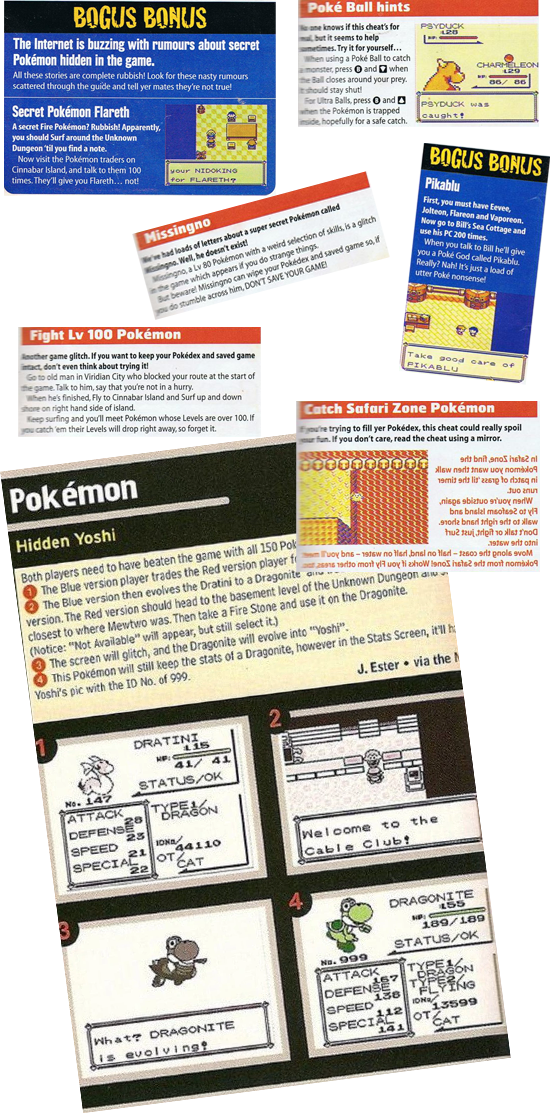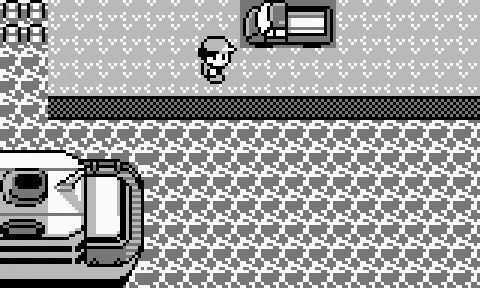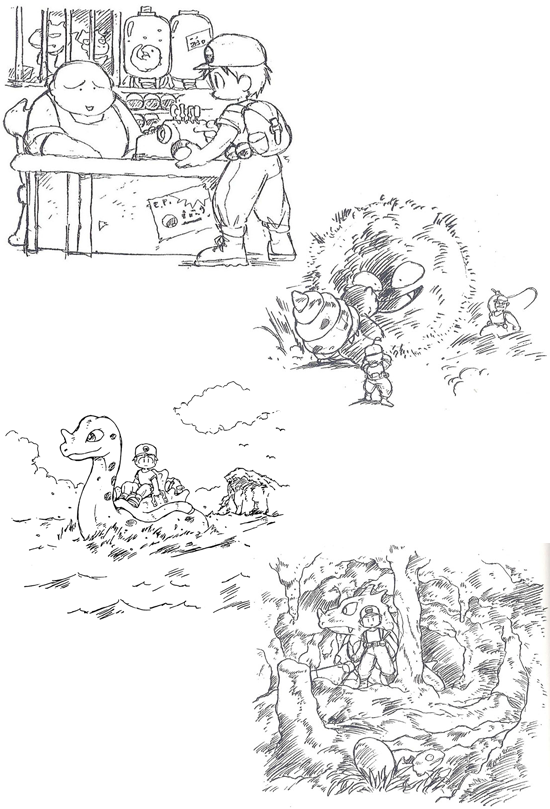












































When people talk about how old video games were better than current ones, an argument that often comes up is that today, developers will frequently publish a glitchy, buggy mess of a game, only to fix it with a number of patches in the weeks and months after its initial release, while pre-DLC era games came out as polished, well-tested products. Pokémon was not one of these games.
On the contrary, the first generation of Pokémon games contain some of the most infamous glitches in video game history. And in this review, I want to argue that their overall glitchiness was indeed one of the factors that made these games so special, and is the reason why so many people are so heavily invested in them up to this day.

Packaging of the English language Pokémon Red & Blue games
When Pokémon came out in the US in September of 1998, and subsequently in Europe in October of 1999, the game had been in development for almost a decade. Creator Satoshi Tajiri and his small team of fanzine-editors-turned-developers, Gamefreak, had presented their initial pitch for what was then called "Capsule Monsters" (later changed to "Pocket Monsters" or "Pokémon") to Nintendo in 1990. The first iteration of the game, Pokémon Red & Green, was published in Japan in February of 1996. An improved version of these initial releases, Pokémon Blue, was developed and saw a limited release as a magazine exclusive later that same year, but only became available in retail stores in 1999, together with the European release of Pokémon Red & Blue. The first Western releases were based on the revised Japanese Blue version, and had made some additional improvements themselves. Yet, the games were far from bug-free (in fact, the US revision had made it worse, as I will explain soon). But that shouldn't become obvious until sometime later.
In 1999, I was 12 years old, making me part of the core demographic these games were marketed towards. And when I say marketed, I mean it was the most elaborate, all-encompassing marketing campaign I had witnessed up to this point in my life. Possibly up to this day. Nintendo had experienced the hype that Pokémon had generated in Japan and was set on reproducing it in the West. Pokémon was everywhere.

90s Pokémon merchandise, as seen in a magazine
There was the anime, which had started running on German TV a month prior to the release of the Game Boy games, getting kids excited to play them. There were free comics, available at any official retailers of Nintendo video games. There was the trading card game, which would prove as massive a hit as the video games themselves. And, of course, there was merch. So. much. merch. Plushies, keychains, stickers, backpacks, yo-yos, cameras, digital Pokédexes, you name it. Kids were crazy about it and spent all of their allowance on Pokémon items, and media were rightfully calling it "Pokémania". I remember a friend gifting me a photo of ANA's Pokémon airplane that her mom had spotted at the airport. Pokémon's first scandal, an episode of the anime (never to be shown overseas) causing mass epileptic seizures in Japanese kids, did not harm its popularity, but brought it even more attention, if that was somehow possible.
I think everyone today (at least everyone I expect on this website) knows what the Pokémon games were about - you are a 10-year-old kid who travels around a sci-fantasy world filled with monsters called Pokémon, you fight those monsters, you catch them in Pokéballs, you build a team and train it, making your monsters evolve and become stronger, and you battle other trainers to eventually become the Poké League champion, all while trying to collect all 150 species to complete your Pokédex. And while most of that wasn't so different from other RPGs already popular at the time, it was the collecting aspect that made this game so different and so popular. You see, this game came in two versions, Red and Blue, and in neither of them were you able to find all 150 creatures. Instead, you needed a link cable and a friend with the other version of the game, and had to trade in the version-exclusives from the other cartridge. There were also Pokémon who would only evolve when traded, and others (like the starters, or the eeveelutions) where you had to pick one out of three, and could never get the other two in you own game. Thus, completing your Pokédex was an almost impossible task, yet this premise spoke so much to everybody's hunter-gatherer instincts that kids went crazy about it.
The rise of Pokémon coincided with the rise of the internet, and while there was an official, printed Nintendo guide on how to play the games available, people would naturally gravitate towards "inofficial" information found in gaming magazines and, of course, on personal websites. And what a treasure trove those were.

Snippets from various magazines, featuring Pokémon glitches and rumours
In fact, Pokémon was the thing that motivated me to create my very first website of my own (more on that in one of my future stories), and the most popular category it featured were "tips, cheats and rumors" (the words "glitches" and "exploits" not really being part of my vocabulary back then). I collected those from all over the internet, and, of course, faithfully tested all of them. Well, except for those that were obvious bs, even to a 12 year old kid. But where did they even come from? This is where we get back to the gen 1 games being the glitchy, buggy mess they were.
Ironically, the spread of the most infamous of all the gen 1 glitches, Missingno., started as official info published in the May 1999 issue of Nintendo of America's "Nintendo Power" magazine (page 101), where they described the method for causing the glitch, while warning against attempting it. This prime example of reverse psychology worked as expected, and soon gamers all over the world were trying it for themselves, spreading the information in magazines, online, and on schoolyards.

An encounter with Missingno.
Encountering the glitch Pokémon Missingno. was easy to do if you knew the steps, yet the results were wild. A simple encounter with the creature, even if fleeing from it, would multiply the item in the sixth slot of your bag - you can imagine that was heavily exploited to obtain unlimited master balls, rare candies, and more. However, it would also partially disrupt game graphics (mostly those in the hall of fame, which was an okay to pay price for having 128 master balls). Catching it - or any of the other Pokémon over level 100 you could encounter via this method - would result in even more chaos.
Interestingly, the "old man" method to get to Missingno., as described by Nintendo Power magazine, was only present in the international versions of the game. While the Japanese original was anything other than free of bugs, this specific route of getting to Missingno., which had to do with how wild Pokémon encounters are determined when surfing on shore tiles, has been paved by the developers who revised the Japanese games for the US release, hence Nintendo of America warning against it. The European versions, in turn, were based on the US version. The glitch occurs exactly the same way as in the English version in the German localization (which is what I played as a kid), while in the French version, Missingno. can be encountered this way, but will make the game freeze. The Italian and Spanish localizations fixed it, but got their own, exclusive Missingno. glitch in return.
Of course, none of this was known to the kids playing the game at that time. Instead, Missingno. was widely regarded as some sort of "secret 152nd Pokémon" - one hundred and fifty-second, as there already was a secret 151st Pokémon, which was, of course, the now well-known Mew. Fun fact about Mew I only learned way later: This common ancestor to all known Pokémon was originally intended to only be a part of Mewtwo's backstory, which can be uncovered via reading various scientists' journals in-game, but never a playable Mon with its own Pokédex entry, sprite, stats and learnset. In fact, Gamefreak employee Shigeki Morimoto sneaked it into the game data very last minute as sort of a prank, unbeknownst to Nintendo.
By the time Pokémon arrived in the West, the fact of Mew's existence in the game data was no longer that much of a secret, especially since at that point, Nintendo had already held various distribution events in Japan, and screenshots of Mew's stats and Pokédex entry were circulating the web. However, the knowledge about both Mew and Missingno. had the most interesting reciprocal effect. I think what went through a lot of gamers' heads back in these days was something along the lines of: (1) Missingno. is a Pokémon we were not supposed to find, but were able to find. So the same must go for Mew, which is also a Pokémon we were not supposed to find.

The location where Mew was supposed to be
And so, the rumors about how to find Mew began - most famously, the "Mew under the truck" rumor, which claimed that if you were able to get to a truck that can be found on a normally unreachable dock close to the SS Anne (a ship which you can board during the course of the game, but which will eventually leave without you), you'd be able to find Mew under it (in the most widespread version of the rumor, you have to move the truck by means of the move Strength). I tried this as a kid, and (disappointedly) confirmed it did not work, but was, for many years, convinced that this was a trick that worked in the Japanese version of the game, but had been disabled for the Western release (which was not the case, either). Still, that truck remains, to this day, a most suspicious object, being a sprite used no-where else in the entire game, placed in a location that you would, under normal circumstances, never have access to.
Of course, by now, it is well-known that there are indeed glitches that can be used to encounter a wild Mew in-game, but since these have been discovered post-2000 and this is a story about the 90s, I'm not gonna go into detail about these now. Instead, let's have a look at the other side of the Missingno.-Mew reciprocity, which went something like: (2) If the hidden-away-in-the-data Pokémon Mew is there because of the known terrifying story about experiments that lead to the creation of Mewtwo, then the hidden-away-in-the-data Pokémon Missingno. must have an equally terrifying, unknown backstory. Or, at least that was what went through my head, don't know about other 12-year-olds.
Indeed, there was some sort of morbid curiosity this glitch Pokémon and all of the other glitches already known at the time (like Glitch City) caused in myself and many others playing the games, with a couple of factors making it hard to know which of these things were actually just a bug and which were intentional, like Mew. After all, back then, Pokémon wasn't yet the well-established, kid-friendly franchise it is today, and no-one could be completely sure what to expect from it. The story about experiments on living creatures gone horribly wrong, as well as the overall worldbuilding, combined with the way rougher character designs, many of them looking actually monstrous, did paint a way darker, more sinister picture than what we think of today when we hear "Pokémon".
![]()
Proto-designs of various Pokémon, including one (Omega, bottom left) that never made it into the games
Turns out, that train of thought wasn't that wrong, at least on a meta level. While Missingno. had no business being in the game, its existence was indeed the result of its creators having overestimated what science can do, trying to erase their horrible mistakes, and releasing a nonviable monstrosity into the wild (insert dramatic lightning and thunder). The creators here being, of course, the developers of the game, who simply miscalculated how much space there was on the Game Boy cartridge. You see, the game was originally meant to feature not 150, but 190 Pocket Monsters, and Missingno. (or, should I say, the 39 different Missingno.s) are the sad remains of those that didn't make the cut, hence the name "Missing Number".
And while these "Missing Numbers", in the finished game, are really nothing but placeholders that shouldn't be visible on the player's end, we later learned a lot about them, through data mining, the publication of the book "Satoshi Tajiri: The Man who Created Pokémon" in 2004 and the manga of the same name in 2018, as well as a leaked copy of the source code and assets for Pokémon Blue in 2020. And in their own way, those Missing Numbers provided a glimpse into what "Capsule Monsters" could have been in a parallel universe, where Game Boy cartridges offered just a little more storage space...
In fact, if you read a bit about the history of Pokémon, you will soon find out that Gamefreak's initial idea featured monsters that would attack you, the player, not just your own monsters, if your charisma value wasn't high enough, and mechanics like "taming" them with the help of a whip. Capsule Monsters might easily have gone into a completely different direction from the Pokémon games we all know and love today, hadn't the development process taken so long and involved so many revisions and subsequent changes. Concerning the fate of the Missing Numbers, today we know that a great number of them eventually made their appearance in Pokémon Gold & Silver or got some sort of reincarnation later, and therefore, weren't actually lost in the long run. There are, of course, a couple Mons among them that would never make their debut, most famously Pikachu's third evolution stage, "Gorochu", who was deemed too overpowered for the game.

Drawings from the original 1990 "Capsule Monsters" pitch
Circling back to my initial thesis of the Pokémon games being so well-loved up to this day precisely because they were so buggy: As a blanket statement, that is, of course, nonsense. And besides the beloved glitches mentioned here, there were also quite a number of obvious mistakes and broken mechanics that made these games, in fact, quite awful in a great number of regards - like, some type matchups not working the way they were supposed to, some types of Pokéballs not working the way they were supposed to, the Safari Zone catching mechanics being completely off, etc.
Nonetheless, the existence of the Missingno. glitch added an unparalleled layer of mystery to the world of Pokémon gen 1, and the background information that was revealed, piece by piece, over the years, helped fuel the fascination and turn gamers like me into "Pokémon archaeologists", mesmerized by all of the artifacts from the past still being uncovered, and by the stories they tell.














